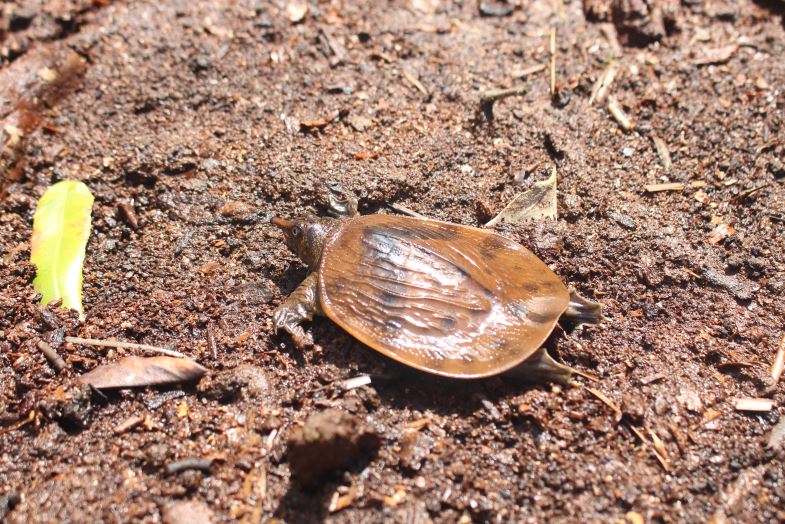February 19, 2025
There are at least 337 species of turtles in the world, including seven varieties of sea turtle. The Indonesian archipelago is home to 39 of these species, with six recorded to date on the Kampar Peninsula. In this article, we take a closer look at each of these species in turn, exploring the unique niches they have made for themselves in their ecosystem, and assessing the current threats – and solutions – to their survival in the wild.
1. Common Soft-shelled Turtle (Amyda cartilaginea)
The common (or Asiatic) soft-shelled turtle can be found throughout Southeast Asia. In Indonesia, this species has made its home in Java, Lombok, Borneo, and Sumatra, where it inhabits freshwater ecosystems such as lakes, rivers, and wetlands. It is clearly recognizable by its elongated snout, which it has evolved as a snorkel for breathing above the silt of riverbeds and bogs in which it buries itself.
2. Bornean River Turtle (Orlitia borneensis)
The largest freshwater hardshell turtle in Southeast Asia, this Critically Endangered species is characterized by a smooth oval shell (or carapace), powerful head, strong jaws, and long claws. It can grow to around 50kg in weight and has large, webbed feet which resemble paddles. To compensate for its weight they are primarily aquatic. Adult males have longer and thicker tails than their female counterparts. It can be told apart from other turtle species in the region by its clear white plastron or underpart shell.
3. Southeast Asian Box Turtle (Cuora amboinensis)
Southeast Asian box turtles are found exclusively in lowland tropical rainforest areas of Southeast Asia, like the peatland swamps of Restorasi Ekosistem Riau (RER). It is called box turtle because of its ability to almost completely seal itself inside its hinged shell.
4. Asian Leaf Turtle (Cyclemys dentata)
This turtle can be found all over Asia, from northern India and Bangladesh to Myanmar, Thailand, Cambodia, Vietnam, Malaysia, and Indonesia (Sumatra, Java, Borneo, and Bali). They can grow 6 to 9.5 inches long and 4.5 to 6.5 inches wide, and are generally quite elusive, blending perfectly with surrounding leaf litter, hence their name. They can often be beneath fruiting trees, especially figs.
5. Spiny Turtle (Heosemys spinosa)
Also known as the ‘cog-wheeled’ turtle, this species takes its name from the ring of protective, spiny growths along the rim of its carapace. Although documented in locations such as Brunei, Indonesia, Malaysia, Myanmar, the Philippines, Singapore, and Thailand, relatively little is known about this turtle, particularly its nesting habits. The spiny turtle buries itself in leaf litter as a form of camouflage during the day, then emerges at night to forage for food. This species is very similar to the Asian leaf turtle, the main difference being its shell is not hinged.
6. Black Marsh Turtle (Siebenrockiella crassicollis)
These small- to medium-sized turtles are almost entirely black in color, except for pale yellow markings on their head. In the wild, they prefer slow-moving or still bodies of water with heavy vegetation. This species is also commonly kept as a pet in Southeast Asia, and in some Buddhist temples is revered as sacred. They are classified as Endangered, due to pressure from the pet trade and illegal meat and medicine markets.

Ecosystem Roles
Each of these turtles play a vital role in the ecosystems they inhabit, as they form a connection between aquatic and terrestrial habitats. Turtles represent nodes in a variety of food webs and play important roles as consumers, prey, and competitors with other species. They also play a key role in recycling nutrients in their ecosystem, and actually provide a living habitat for various invertebrates and microorganisms. As predators, turtles help control wild populations of small creatures such as snails and insects, thereby maintaining the delicate balance of river, lake, and estuarine ecosystems.
Threats to Survival
All over the world, human activity has exacerbated the decline of turtle habitats and decimated wild populations. Today, around half of the world’s freshwater and marine turtle species are currently facing extinction. Most turtle species in Indonesia are currently categorized as Near Threatened or higher in the IUCN Red List of threatened species.
Common threats to turtles include hunting and demand from the international pet trade. Pollution of their habitats and habitat destruction are also serious threats. Due to their slow rate of reproduction and the high mortality of eggs and juveniles, turtle populations are more vulnerable to these stressors than other species. This means turtle populations can take a long time to recover from a sudden decline, and makes conservation efforts absolutely essential to their survival.
Another threat is bycatch, where turtles are accidentally caught in fishing nets and traps. To reduce this threat, RER works together with fishers to encourage them to release trapped turtles.
Turtle Conservation in RER
The RER program is an international collaboration that brings together private and public sector actors to protect and restore ecologically important peat swamp forest areas on Indonesia’s Kampar Peninsula and Padang Island, on the east coast of Sumatra. By restoring these habitats and monitoring them effectively, RER is helping turtle populations to bounce back.
Established by APRIL Group in 2013, RER adopts an integrated, landscape-level approach to protect, assess, restore, and manage 150,693 hectares of previously deforested or degraded peatlands as a unique, biodiverse forest area. The overall objective is to restore the ecologically significant peat swamp forests and generate multiple ecosystem benefits through broad stakeholder and community collaboration.
Supported by long-term resources and expertise from partners Fauna & Flora, Bidara, and APRIL Group, RER works with local communities to strengthen ongoing conservation initiatives for turtles and various other species of flora and fauna on the Kampar Peninsula, as part of a 60-year ecosystem restoration license granted by the Indonesian Ministry of Environment and Forestry.
By working together to study these incredible animals, restore their habitats, and reduce the most pressing threats to their survival, the RER program is helping to bring each of these six turtle species back from the brink of extinction.